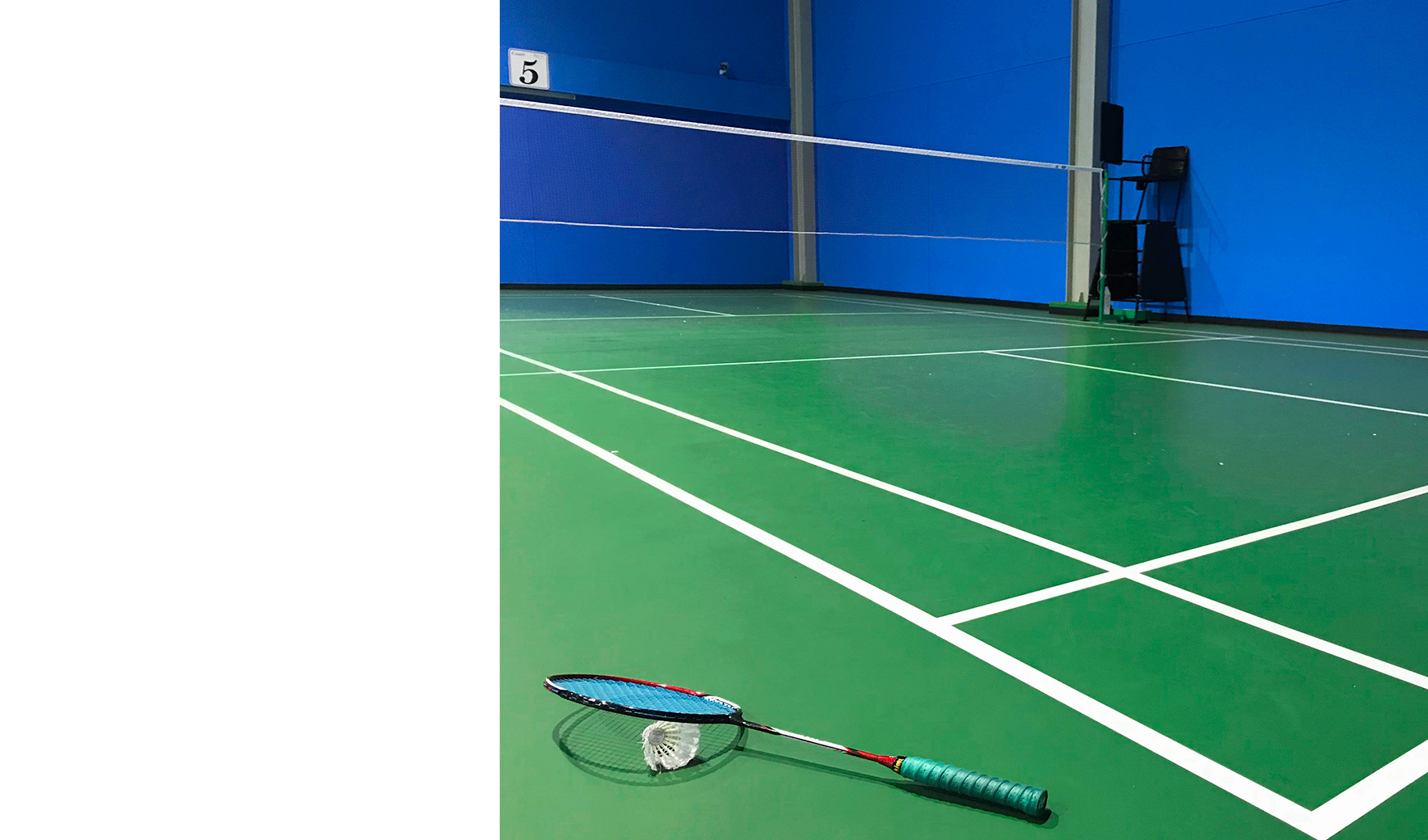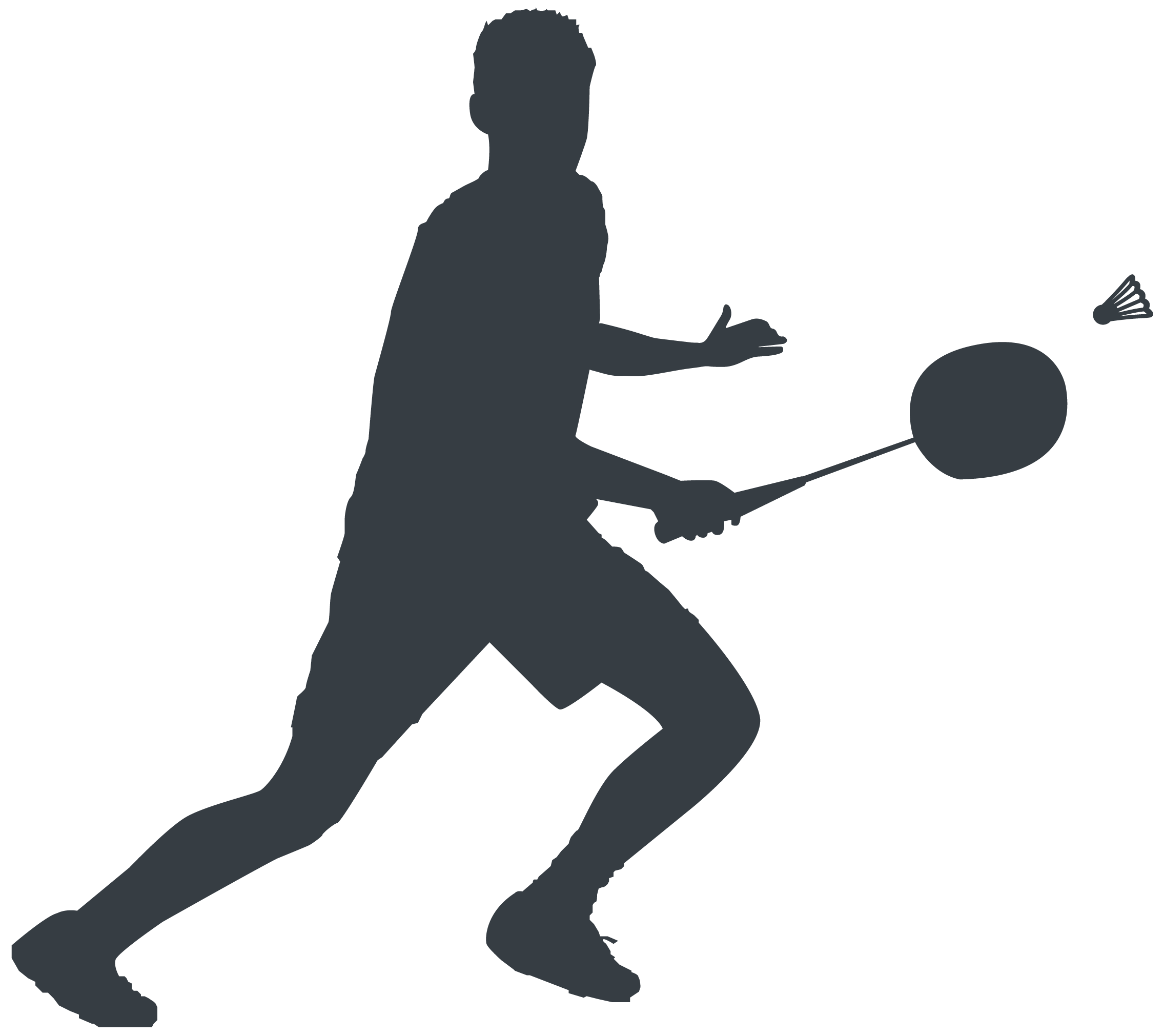Ankle injuries, such as ankle sprains and fractures, are one of the most common badminton injuries.

Badminton is a racquet sport often played as singles or doubles, hitting a shuttlecock or ‘birdie’ across a net. It was first included in the Summer Olympics in 1992 and is governed locally by Badminton BC. Injuries to the lower extremities are most common, including sprains and fractures, as well as shoulder injuries.
(see Section 04 - Prevention)
Ankle injuries, such as ankle sprains and fractures, are one of the most common badminton injuries.
There is a high incidence of Achilles tendon rupture in badminton players. Achilles tendon injuries most commonly occur at the middle or end of a badminton game.
Injuries to the anterior cruciate ligament (ACL) of the knee can occur from playing badminton. ACL injuries most frequently occur from a single leg landing after an overhead badminton stroke.
Although lower extremity injuries are the most frequent, shoulder injuries and shoulder pain are also common among badminton players.
Eye injuries can occur in badminton. Most commonly is a closed globe injury, which is an eye injury that does not break the eye wall due to a blunt object hitting the eye at high speed.
The lower limb is the most common region to sustain an injury in badminton representing 52% of all injuries, which includes ligament sprains, muscle, or joint injuries.
It is estimated that...

The majority of badminton injuries occur to the lower extremities. These injuries commonly happen during movements involving turning, changing direction, shifting weight, pivoting, twisting, and landing.
Training and regular practice are expected of athletes, but how much is too much? Your risk of injury can increase if you train too much or improperly. Learn more about how to find your training load “sweet spot.”
Some muscle soreness or joint pain is expected when increasing your level of physical activity. It is important to listen to your body for persistent or worsening pain, and to know when to rest. Learn more about how to prevent injuries in badminton.
Talk to your coach or organization about the prevention strategies below and how they might be incorporated into training and policies.
Protective eyewear is recommended to product the eye from injuries that in severe cases may have potential to cause vision loss. Increased advocacy efforts and improved designs of eyewear are essential to enhance compliance.
The risk of all lower body injuries may be reduced by up to 50% by regular participation in a balance training exercise program with a resistance training component, such as a neuromuscular training warm-up program.
Sport Injury Prevention Research Centre Neuromuscular Training
The Sport Injury Prevention Research Centre has developed a neuromuscular training warm-up program that can be adapted to many sports. Incorporating a warm-up program like this one into your training program at least two times per week has been associated with a significant reduction in lower body injuries.
Click here to view poster.
Oslo Sport Trauma Research Centre Neuromuscular Training
Adopt strength training exercises designed to prevent injuries to the shoulder and back. The Oslo Sport Trauma Research Centre has developed exercises that specifically help keep the shoulder strong and reduce the risk of shoulder and back injuries. This resource includes videos and PDFs for download.
Learn more about exercises to help prevent shoulder injuries.
Learn more about exercises to help prevent back injuries.
For more exercises, visit http://fittoplay.org/.
Get Set Neuromuscular Training
The Get Set app contains exercises that can be done at home. Created by the Oslo Sports Trauma Center, Norwegian School of Sport Sciences, and Making Waves AS in 2014 for the International Olympic Committee, the app allows you to search by body part to view exercises that work to strengthen each area of the body, or search by sport to view a library of exercises that are specific to badminton.
Download Get Set for Android.
Download Get Set for iOS.
Sleep, Vigilance and Sport Injury Prevention
Being successful in physical activity requires a high degree of alertness, also known as vigilance. Sufficient sleep helps your body to recover, allows you to achieve your goals, and reduces your risk of injury. Getting less than 8 hours of sleep can increase your rate of injury by up to 70%! Watch this video to learn more about how sleep and vigilance are connected.
Sport-related Physicals
Badminton is a physically demanding sport and some pre-existing conditions may increase the risk of injury. An annual sport-related physical evaluation ensuring fitness to play can help to reduce risk of injury. KidsHealth provides information about what sports physicals are, why they may be appropriate and where you may go to get them.
Learn more about Kids Health Sports Physicals.
Talk to your organization or school about the prevention strategies below and how they might be incorporated into training and policies.
Protective eyewear is recommended to product the eye from injuries that in severe cases may have potential to cause vision loss. Increased advocacy efforts and improved designs of eyewear are essential to enhance compliance.
The risk of all lower body injuries may be reduced by up to 50% by regular participation in a balance training exercise program with a resistance training component, such as a neuromuscular training warm-up program.
Sport Injury Prevention Research Centre Neuromuscular Training
The Sport Injury Prevention Research Centre has developed a neuromuscular training warm-up program that can be adapted to many sports. Incorporating a warm-up program like this one into your training program at least two times per week has been associated with a significant reduction in lower body injuries.
Click here to view poster.
Oslo Sport Trauma Research Centre Neuromuscular Training
Encourage your players to adopt strength training exercises designed to prevent injuries to the shoulder and back. The Oslo Sport Trauma Research Centre has developed exercises that specifically help keep the shoulder strong and reduce the risk of shoulder and back injuries. This resource includes videos and PDFs for download.
Learn more about exercises to help prevent back injuries.
Learn more about exercises to help prevent shoulder injuries.
For more exercises, visit http://fittoplay.org/.
Get Set Neuromuscular Training
The Get Set app contains exercises that can be done at home. Created by the Oslo Sports Trauma Centre, Norwegian School of Sport Sciences, and Making Waves AS in 2014 for the International Olympic Committee, the app allows you to search by body part to view exercises that work to strengthen each area of the body, or search by sport to view a library of exercises that are specific to badminton.
Download Get Set for Android.
Download Get Set for iOS.
Sport-related Physicals
Badminton is a physically demanding sport and some pre-existing conditions may increase the risk of injury. An annual sport-related physical evaluation ensuring fitness to play can help to reduce risk of injury. KidsHealth provides information about what sports physicals are, why they may be appropriate and where you may go to get them.
Learn more about Kids Health Sports Physicals.
Facilities
The Ontario Physical Education Association (OPHEA) provides recommendations for safely implementing badminton in elementary schools.
Learn more about implementing badminton in elementary schools.
Talk to your coaches, teachers, organization, or school about the prevention strategies below and how they might be incorporated into training and policies.
Protective eyewear is recommended to product the eye from injuries that in severe cases may have potential to cause vision loss. Increased advocacy efforts and improved designs of eyewear are essential to enhance compliance.
The risk of all lower body injuries may be reduced by up to 50% by regular participation in a balance training exercise program with a resistance training component, such as a neuromuscular training warm-up program.
Click here to view poster.
Oslo Sport Trauma Research Centre Neuromuscular Training
The Oslo Sport Trauma Research Centre has developed exercises that specifically help keep the shoulder strong and reduce the risk of shoulder and back injuries. This resource includes videos and PDFs for download.
Learn more about exercises to help prevent back injuries.
Learn more about exercises to help prevent shoulder injuries.
For more exercises, visit http://fittoplay.org/.
Get Set Neuromuscular Training
The Get Set app contains exercises that can be done at home. Created by the Oslo Sports Trauma Centre, Norwegian School of Sport Sciences, and Making Waves AS in 2014 for the International Olympic Committee, the app allows you to search by body part to view exercises that work to strengthen each area of the body, or search by sport to view a library of exercises that are specific to badminton.
Download Get Set for Android.
Download Get Set for iOS.
Sport-related Physicals
Badminton is a physically demanding sport and some pre-existing conditions may increase the risk of injury. An annual sport-related physical evaluation ensuring fitness to play can help to reduce risk of injury. KidsHealth provides information about what sports physicals are, why they may be appropriate and where you may go to get them.
Learn more about Kids Health Sports Physicals.
Facilities
The Ontario Physical Education Association (OPHEA) provides recommendations for safely implementing badminton in elementary schools.
Learn more about implementing badminton in elementary schools.
The role of health professionals in preventing badminton injuries has two main components:
Protective eyewear is recommended to product the eye from injuries that in severe cases may have potential to cause vision loss. Increased advocacy efforts and improved designs of eyewear are essential to enhance compliance.
The risk of all lower body injuries may be reduced by up to 50% by regular participation in a balance training exercise program with a resistance training component, such as a neuromuscular training warm-up program. To address the common injuries to the lower body, back and shoulders, the following exercises are recommended.
Sport Injury Prevention Research Centre Neuromuscular Training
The Sport Injury Prevention Research Centre has developed a neuromuscular training warm-up program that can be adapted to many sports. Incorporating a warm-up program like this one into the coach’s training program at least two times per week has been associated with a significant reduction in lower body injuries.
Click here to view poster.
Oslo Sport Trauma Research Centre Neuromuscular Training
The Oslo Sport Trauma Research Centre has developed exercises that specifically help keep the shoulder strong and reduce the risk of shoulder and back injuries. This resource includes videos and PDFs for download.
Learn more about exercises to help prevent back injuries.
Learn more about exercises to help prevent shoulder injuries.
For more exercises, visit http://fittoplay.org/.
Get Set Neuromuscular Training
The Get Set app contains exercises that can be done at home. Created by the Oslo Sports Trauma Centre, Norwegian School of Sport Sciences, and Making Waves AS in 2014 for the International Olympic Committee, the app allows you to search by body part to view exercises that work to strengthen each area of the body, or search by sport to view a library of exercises that are specific to badminton.
Download Get Set for Android.
Download Get Set for iOS.
Sport-related Physicals
Badminton is a physically demanding sport and some pre-existing conditions may increase the risk of injury. An annual sport-related physical evaluation ensuring fitness to play can help to reduce risk of injury. The American Academy of Pediatrics provides information about preparticipation physical evaluation.
Learn more about Preparticipation Physical Evaluation.
